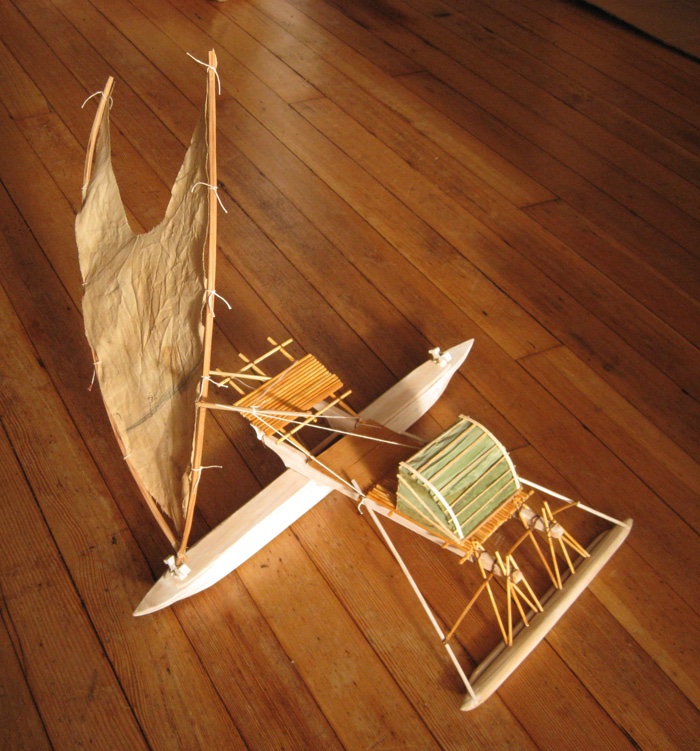-
Posts
429 -
Joined
-
Last visited
Content Type
Profiles
Forums
Gallery
Events
Album Comments posted by Harvey Golden
-
-
Thank you!
-
Thank you. Yes, there's a lot of books on kayaks out there, though not always easy to find. Arima's writings are the best there is for Canadian Inuit kayaks. He writes that red ochre and crushed "black stone" mixed with oil were the paints used on kayaks around West Hudson Bay. Elsewhere, charcoal/soot and even octopus inks were used for black.
All the best, Harvey
-
Thank you! That is very helpful. I'll check out your website-- thank you again!
Best, Harvey
-
Beautifully done! May I ask which books have information on such boats? I've tried to find detailed books on traditional Japanese boats, but have come up with hardly anything save for a couple of superb books by Douglas Brooks.
-Harvey
-
8 hours ago, Gbmodeler said:
Love it! You really captured the look of these boats, and great colors too!
Thank you! It's a funny thing about that blue. . . Chapelle writes "The decks were painted yellow, green, or with the hard unpleasant blue used in some Mediterranean boats." The shade I chose is quite unpleasant to my eyes, but gosh it sure works when on the water with the sun out.
-
On 1/22/2021 at 11:15 AM, wefalck said:
Harvey, the one the distinctive crab-claw sail in the image above is another one on my list, the museum in Berlin has an original one.
Dear Eberhard, Yes, and thank you: Your photographs of the Berlin Vaka helped me make the model! Best, H- P.S. These sail yet again: https://www.vaka.org/gallery
-
1 hour ago, wefalck said:
Ahh, you are interested in kayaks too ! And canoes ?
A few years ago I happened to work in one of the French institutes for Arctic studies and as a kind of bonus lesson we could give on a pet subject, I gave one on kayak typology and construction.
Where did you get the drawings from, form Adney & Chapelle (1964) ? I have quite a collection of books on indigeneous kayaks. However, as I am working in small scales, kayaks are not so interesting and practical subjects.
Talking about Adney, a bark canoe, perhaps a 'voyageur' one, is also on my list.
Eberhard
Dear Eberhard, Yes, kayaks are an interest of mine. I saw the skin boat bibliography you had posted, and I am one of your authors on the list (I've since come out with another title on Alaskan kayaks). I build very few models of kayaks because I typically build them full-size instead: http://www.traditionalkayaks.com/Kayakreplicas/KayakReplicas.html . I have built replicas from Chapelle's drawings as well as others, but have mostly built from my own drawings and research in museums and private collections. Thank you and all the best, Harvey
-
Dear Wefalck,
I hadn't thought to post it in the general forum section-- am new here and still finding my way around. Thank you for the comments. I've long known about your web-page featuring photographs of the outrigger canoes in Berlin, so it is good to meet you. I have built perhaps 15 other Pacific Island canoes, mostly from Haddon & Hornell, but also from other sources (Neyret, Gladwin, Doran, Cook, Dodd, etc.) I'll have a look at your models-- thank you! I'm happy to meet another interested in these craft.
-
10 hours ago, DelF said:
Stunning. How did you reproduce the sea?
Thank you! The photo was taken on the river here. I can't build a model without floating it at least once.
-
56 minutes ago, DelF said:
How did you reproduce the skin covering?
I used scraps of parchment deer rawhide. I soaked them until they were pliable and thick, and sewed three scraps end-to-end, and then made a "sock" with the front half, pulled it onto the frame, and then sewed up the back deck ridge (adding extra pieces as needed). The bow aperture was then cut open and then stitched to form. The skin is sewn to itself below the cockpit coaming rim. Essentially the same general process as a full-size one would have been made, but they would have used double water-proof stitching, which is hard to do at this scale. Once done, the drying skin tightens in place (and puts a tremendous strain on stitching and the frame itself).
-
That's the hat the paddler would have worn. Beautifully done.
-
Sorry for the late reply-- I only just found how to view and reply to comments. These boats are/were built by Japanese immigrants to Hawaii. Sucher's book gives a brief but clear history of these forms-- origin and later developments. And yes, the term Sampan is applied loosely considering later developments of these types. Thank you!
Harvey
-
7 hours ago, catopower said:
What a very cool subject and a really nicely done model!
What scale did you build this in and what did you use for the hide?
Thank you! 7/8"=1' The hide is a scrap of tanned deerskin. Original would have been sea mammal rawhide. Rawhide moves like crazy, and is liable to crush models (and even full-size craft) if the stitching doesn't tear first. Will post a rawhide model sometime soon...





in Gallery of COMPLETED Scratch-built models
Posted
Thank you! You probably saw the stove in the bow that lead me to make one for the model. Great museum in Astoria.